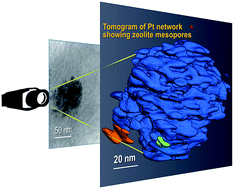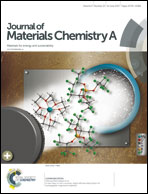Tomographic imaging of pore networks and connectivity of surfactant-directed mesoporous zeolites†
Abstract
Zeolites of MFI, MTW, *MRE and beta frameworks were synthesized by a method using micropore–mesopore dual generating surfactants. The porous texture of the zeolites was characterized by electron tomography and argon adsorption after the removal of the surfactant by calcination. For high-contrast tomography, the zeolites were supported with platinum. The resultant tomograms showed disordered and interconnected networks of Pt nanowires and nanosheets, which corresponded to the shape of the surfactant-directed mesopores. In the calcined zeolites, both the mesopores and zeolitic micropores were fully accessible for argon adsorption. Before calcination, however, no pores were accessible even after being thoroughly washed with solvent. The result indicated that the surfactant head could be tightly encased within the micropores after guiding the formation of the zeolite framework as a part of the mesopore wall, so that the surfactant was difficult to remove by solvent washing. After calcination, the micropores and mesopores could be connected through an aperture in which the neck of the surfactant molecule had been located. Neohexane was adsorbed very rapidly due to the micropore–mesopore connectivity. The hierarchical pore connectivity is an important and characteristic feature of the surfactant-directed zeolites for application in high performance adsorption and catalysis.



 Please wait while we load your content...
Please wait while we load your content...